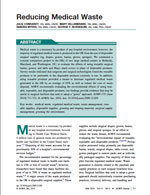 Reducing Medical Waste
Reducing Medical Waste
Medical waste is a necessary by-product of any hospital environment; however, the majority of regulated medical waste is produced in the OR from the use of disposable surgical supplies (eg, drapes, gowns, basins, gloves, sponges). We conducted a concept comparison project in the ORs of two large medical centers in Bethesda, Maryland, and Washington, DC, to evaluate the effects of using reusable surgical basins, gowns, and table and Mayo stand covers in place of disposable products. Survey results indicated that surgeons and surgical technologists found the reusable products to be preferable to the disposable products currently in use. In addition, using reusable products provided a means to decrease regulated medical waste generated in the OR by an average of 65% as well as reduce the cost of waste disposal. AORN recommends evaluating the environmental effects of using reusable, reposable, and disposable products; our findings provide evidence that may be useful to surgical facilities that seek to adopt a “green” approach. AORN J 91 (June 2010) 711-721. AORN, Inc, 2010. doi: 10.1016/j.aorn.2009.12.029
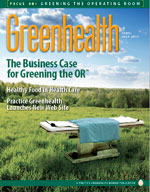 The Business Case for Greening the OR
The Business Case for Greening the OR
The operating room is critical to a hospital’s success, and to its business model—bringing in between 40-60% of the organization’s revenue1, 2 and up to 60% of its operating margin in some instances.3 The OR is also a significant cost center. It is the leader in medical supply usage for the entire hospital,4 estimated to account for approximately 33 percent of all hospital supply costs, 5 and has large cost requirements relative to energy use and waste management.
But hospitals across the country are demonstrating that there are ways to cut costs in the OR while reducing the environmental footprint of the department.
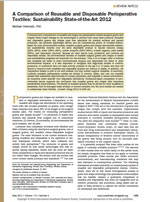 A Comparison of Reusable and Disposable Perioperative Textiles: Sustainability State-of-the-Art 2012
A Comparison of Reusable and Disposable Perioperative Textiles: Sustainability State-of-the-Art 2012
Contemporary comparisons of reusable and single-use perioperative textiles (surgical gowns and drapes) reflect major changes in the technologies to produce and reuse these products. Reusable and disposable gowns and drapes meet new standards for medical workers and patient protection, use synthetic lightweight fabrics, and are competitively priced. In multiple sciencebased life cycle environmental studies, reusable surgical gowns and drapes demonstrate substantial sustainability benefits over the same disposable product in natural resource energy (200%–300%), water (250%–330%), carbon footprint (200%–300%), volatile organics, solid wastes (750%), and instrument recovery. Because all other factors (cost, protection, and comfort) are reasonably similar, the environmental benefits of reusable surgical gowns and drapes to health care sustainability programs are important for this industry. Thus, it is no longer valid to indicate that reusables are better in some environmental impacts and disposables are better in other environmental impacts. It is also important to recognize that large-scale studies of comfort, protection, or economics have not been actively pursued in the last 5 to 10 years, and thus the factors to improve both reusables and disposable systems are difficult to assess. In addition, the comparison related to jobs is not well studied, but may further support reusables. In summary, currently available perioperative textiles are similar in comfort, safety, and cost, but reusable textiles offer substantial opportunities for nurses, physicians, and hospitals to reduce environmental footprints when selected over disposable alternatives. Evidenced-based comparison of environmental factors supports the conclusion that reusable gowns and drapes offer important sustainability improvements. The benefit of reusable systems may be similar for other reusables in anesthesia, such as laryngeal mask airways or suction canisters, but life cycle studies are needed to substantiate these benefits. (Anesth Analg 2012;114:1055–66)
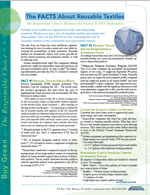 The FACTS About Reusable Textiles
The FACTS About Reusable Textiles
Perhaps your healthcare organization only uses disposable products. Maybe you use a mix of reusable textiles and single-use disposables. Here are the FACTS on why increasing the use of reusable textiles is the sustainable and responsible choice!
The new focus on Green has every heatlhcare organization looking for ways to reduce waste and costs while increasing the sustainability of daily operations. Reusable textiles can dramatically reduce your waste, provide effective barrier protection and enhanced comfort, as well as reducing costs.
Sounds straightforward, right? But companies offering nonwoven, single-use disposables claim their products are the more sustainable choice. So who is right? The following information provides the FACTS, backed by research and case studies.
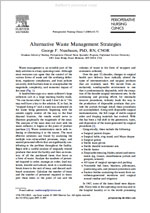 Alternative Waste Strategies
Alternative Waste Strategies
Waste management is an invisible part of the daily activities in a busy operating room. Although most everyone can agree that the control of the various forms of waste and the confusing definitions, regulatory compliances, and local policies are costly, little has been done to conceptualize the magnitude, complexity, and economic impact of the issue.
Download Full Article (PDF)
 OR Sustainability: Healthcare Gone Green
OR Sustainability: Healthcare Gone Green
According to a recent study by the University of Chicago, the healthcare sector accounts for about 8 percent of greenhouse gases. Furthermore, other studies suggest operating rooms generate tremendous amount of waste: roughly 20-30 percent of a facility’s total waste. This is a major environmental issue, and it’s one the healthcare industry is going to have to take very seriously moving forward. With that in mind, three industry experts discussed OR sustainability and green healthcare.
